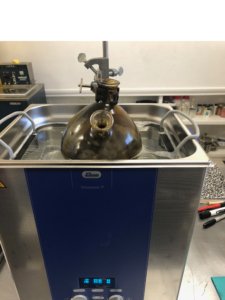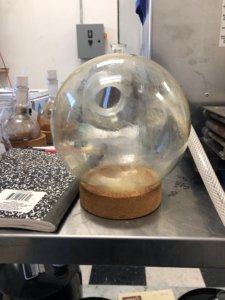How to Quickly Clean Glass Components Used in Cannabis Processing
Cannabis processors using glass components for short path distillation must deal with accumulated baked-on, polymerized and other contaminants that are extremely difficult and time consuming to remove. These glass components represent substantial investments and, unfortunately, can be easily broken unless handled carefully. This post explains why ultrasonic cleaners are often the answer to quickly clean glass components used in cannabis processing.
This blog covers the following:
- Challenges associated with cannabis distillations and concentrates
- The ultrasonic cleaning option for glass components
- Selection criteria for ultrasonic cleaners
- Ultrasonic cleaner features to consider
- Suggested cleaning procedures
Glass Cleaning Challenges in Cannabis Processing

Cleaning glass components used to produce cannabis concentrates can be a high-maintenance activity because the process of distillation involves crude concentrates that are boiled until the desired components are distilled out, leaving behind unwanted residues.
One method involves the time-consuming operation of manually removing tenacious contaminants before equipment can be reused while stocking additional equipment on site to keep production down-times at a minimum. There’s also frequent replacement of distillation and other processing glassware broken during cleaning.
Cleaning itself can be somewhat risky if it involves baths containing caustic chemicals as a necessary inconvenience to assure clean glassware is available to continue production. There are two downsides to this practice:
- When caustic chemicals are used, the residence time for glass can be lengthy in order to break through layers of plasticization, thus delaying return to service.
- The chemicals are dangerous to handle at high concentrations and need to be disposed of safely. This generally involves contracting with a chemical disposal service that may require storing on site in containers such as 55-gallon drums. In addition to costs involved, stowing drums on site is in itself an undesirable situation.
Another alternative is hand scrubbing using abrasive mixtures. This does do not bode well for hands or, for that matter, the glass.
A more efficient and environmentally friendly alternative is employing ultrasonic cleaners to quickly clean glass components used in cannabis processing. Rather than using solvents, toxic chemicals or abrasives, ultrasonic cleaners employ environmentally friendly biodegradable cleaning solution formulations and the power of ultrasonic cavitation.
The Ultrasonic Cleaning Option
Ultrasonic cleaners are fitted with transducers attached to the bottom and/or sides of a tank filled with a cleaning solution. When activated by generators, transducers cause the tank bottom to serve as a vibrating membrane at frequencies measured in thousands of cycles per second (kilohertz), sending sound waves pulsing through the cleaning solution.
These waves produce millions of tiny vacuum bubbles that shoot out a powerful jet of liquid—on the order of 10,000 psi—when imploding. The force of the implosions, called cavitation, lifts and carries away contaminants from objects being cleaned.
The cleaning process is tough enough for engine parts but gentle enough for electronics and surgical instruments – and for glassware and other equipment used in short path distillation.
Selection Criteria for an Ultrasonic Cleaner
Cleaning is accomplished in tanks. Ultrasonic cleaners are offered in a wide range of tank capacities available from elmaultrasonic.com.
Measure the dimensions of the largest pieces of cannabis production equipment to be cleaned. Select a tank that will accommodate them – to assure that parts are fully immersed in the cleaning solution. Take into account that cleaning is accomplished in baskets with dimensions slightly smaller than the tank.
Solving Challenges Specific to Cleaning Flasks
A benefit of ultrasonic cleaning technology is that the cavitation that blasts away contaminants can occur inside round-bottom multi-necked flasks and similar containers immersed in and filled with the cleaning solution formulation.
This is because the sound waves pass through the glass to act on the cleaning solution inside.
We’ll get more into how you can accomplish this under the cleaning solution formulations section below.
What to Look For in Ultrasonic Cleaner Features
While ultrasonic cleaners are available in most any price range you should look for units that offer features especially useful for cleaning glassware used in cannabis processing. Here are some points to consider:
Ultrasonic Frequency
Ultrasonic frequency determines the size of the vacuum bubbles that do the cleaning.
A lower frequency such as the 37 kHz Elmasonic E+ and Elmasonic S series produces relatively large bubbles. When these bubbles implode they release a stronger cleaning energy. Exceedingly tenacious deposits on glassware can be effectively removed at lower frequencies.
A higher frequency produces smaller cavitation bubbles. These cover fine featured complex surfaces more thoroughly and are gentler than low frequencies. Frequencies such as 80 kHz or higher can more effectively penetrate narrow apertures such as in tubing.
Because short path distillation can create a variety of cleaning challenges dual-frequency ultrasonic cleaners may prove more cost-effective in the long run. An example is the Elmasonic P series offering user-selectable 37 or 80 kHz.
6 Other Useful Features for Cleaning Short Path Distillation Equipment
Among features offered by ultrasonic cleaner manufacturers 5 may prove particularly useful.
- Sweep is a small but automatic ± variation in ultrasonic frequency. What it does is provide uniform distribution of cavitation action thereby avoiding areas of no or intense cleaning plus what is called harmonic vibration.
- Degas speeds the removal of cavitation-inhibiting trapped air in fresh cleaning solutions. While this can be accomplished by running the equipment with no cleaning load, it is faster especially when using large cleaning tanks.
- Pulse provides a boost of ultrasonic energy and is activated to remove particularly tenacious contaminants.
- Variable power (together with ultrasonic frequency options) allows users to develop optimum cleaning programs based on what is being cleaned and the nature of the contaminants.
- Timers allow operators to “set and forget” cleaning cycle duration, freeing them up to perform other tasks.
- Heaters bring the cleaning solution formulation to the temperature recommended by the manufacturer. While ultrasonic energy in itself heats the solution, heaters do it faster.
Cleaning Solution Formulations for Short Path Distillation Equipment

As noted earlier, caustic cleaning solutions and manual scrubbing with abrasives are not attractive methods to protect investments in glassware and other equipment used in cannabis processing operations.
Two biodegradable cleaning solution concentrates that can be diluted with water have proven highly effective.
- Cleaning solution CLN-SC75 with a pH of 3.5 can be used full strength or diluted to 50% with water in an ultrasonic cleaner.
- Elma tec clean S2 with a pH <1 in concentrate form is diluted to 1 to 5% with water. A representative cleaning cycle is 2 to 5 minutes depending on the extent of contamination.
Both formulations are available from elmaultrasonic.com and are characterized as biodegradable. Local health department regulations should be followed regarding disposal of spent cleaning solutions.
Cleaning Internal Flask Surfaces
As noted above cavitation can safely remove contaminants that deposit inside containers such as round-bottom multi-necked flasks. As tenacious contaminants are not likely to occur on outside flask surfaces, it is not necessary to fill the entire cleaning tank with a cleaning solution formulation.
Here is a suggested procedure:
- Add water and a wetting agent such as dishwashing detergent to the ultrasonic cleaner tank fill line.
- Fill flasks with enough diluted cleaning solution to fully cover the contaminants.
- Place the base of the flasks in the water – full immersion is not necessary. Trays and clamps are available to support flasks during the cleaning cycle.
- Activate the ultrasound. Cavitation passes through flask walls and acts on the contaminants.
Experimentation Helps Establish Procedures
Ultrasonic cleaning can quickly clean glass components used in cannabis processing. Contact the scientists at elmaultrasonic.com for help in selecting an ultrasonic cleaner, cleaning solution formulation, and cleaning procedures that can help you increase the efficiency and lower the costs of your cannabis processing operations.
This post is based on an article published in Labcompare.


